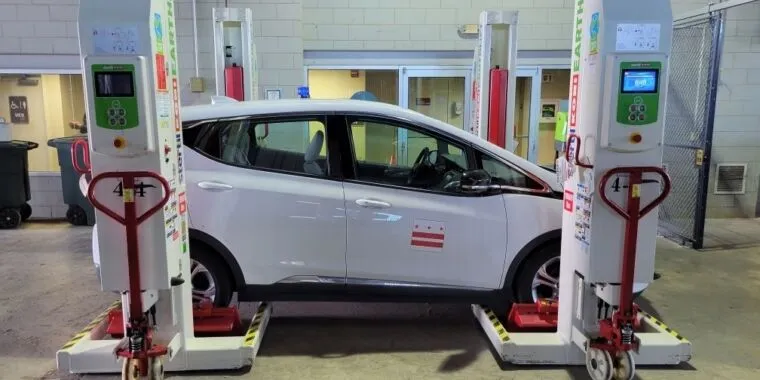The Energy Management Module claims it can “rejuvenate a battery” somehow.
The District of Columbia has signed a $680,000 contract for an impossible-sounding gadget that claims to increase the range of an electric vehicle by 60 percent. The contract was signed in May, but it mostly slipped under the radar until it was picked up by WUSA9 this month.
The gadget in question is called an Energy Management Module, and it’s made by a company called Mullen, which has recently been acquiring struggling electric vehicle startups like Bollinger and Electric Last Mile Solutions. In April, Mullen published a press release claiming that fitting the EMM gadget to one of the company’s prototype cargo vans “showed more than a 75 percent increase in range for the 42-kWh lithium-ion battery pack.”
DC’s Department of Public Works became aware of the EMM device at last year’s Washington Auto Show, according to WUSA9. “We have been investigating new technology that would extend their life, make us work more efficiently, and keep our maintenance expenses down,” the department told the news channel.
The DC government owns more than 100 Chevrolet Bolt EVs as part of its fleet, some of which are used for duties like parking enforcement. It has fitted 40 Bolts with EMM devices at a staggering cost of $14,000 per vehicle, plus an additional $3,000 per EV for “data monitoring.”
The device’s inventor, Lawrence Hardge, claims that it works by “rejuvenating the battery,” which sounds as close to a load of nonsense as I’ve heard in some time, given the relatively advanced nature of the Bolt’s battery management system and the ease with which one can check the battery’s health.
WUSA9 found reason to be skeptical of Hardge’s claims—which include allegedly being nominated for a Nobel Prize by the University of Michigan—thanks to a fraud conviction in 2001.
There’s a pretty long history of bogus gadgets promising ludicrously unrealistic increases in efficiency. From magnets that wrap around your fuel line to a “voltage stabilizer” you plug into a 12 V socket, none have ever actually worked because they invariably defy the laws of physics. Unfortunately, relying on the naïvety of your customers has always been a good way to get paid.
In the case of those internal combustion engine-focused frauds, at least they kept their claims somewhat plausible, usually promising efficiency increases of 10–20 percent. But Mullen’s EMM simply defies belief with claims of a 60 percent boost.
Needless to say, it appears that the DC government has been taken for a ride here. Thankfully, someone somewhere down the line was awake—the contract states that DC will only pay the $680,000 once all 40 units have been shown to be working.
It’s probably worth pointing out that they cancelled the contract without paying anything:
Six weeks after we alerted DC about Hardge and his claims, on July 13, DC government told WUSA9 it “terminated” the contract due to “violations of terms of the agreement.” It added DC would not pay Hardge any money.
But WUSA9’s questions remain: How did a convicted felon with an invention not independently tested and deemed impossible by experts get a lucrative contract with the D.C. government, and access to government equipment? We’ve asked D.C. government to explain that to us, but they’ve declined an interview.
In cases like this I find that they’re usually related to somebody.
There’s a reality here where someone saw this as a no-lose situation. Either:
A. We get some improvement, but it doesn’t reach their claims so we don’t go forward.
Or
B. We get the promised improvement and it’s actually worth it.
They missed a few obvious issues in that the cars may become safe or get worse longevity from the experiment. That and the contract process took time and money if they had a reasonable expectation of failure.
Still, it’s not entirely stupid and so long as Mullen got NOTHING besides a scam record, this could be a win.
Pretty picture you’re painting, but the cost/benefit of this is completely unreasonable even if it worked as advertised.
In any scenario where it’s less than advertised the economics of it gets even worse.
So, no, this is entirely stupid/foolish.
So, ignoring the fees involved in making it happen at all (which I assume the person did, because wow.) Say they spend ⅓ the price of the car to get ⅔ again as much use out of it. That’s a profit. They’re probably looking at replacing the car and not the battery when thinking about it, so it’s really good then. And they probably assume the device is transferable, so they can get more than one use out of the investment.
So they’re selling themselves on almost 2x performance that they can apply to all future batteries or cars and thus they extend the life of each car in the fleet by a lot.
And if it’s doesn’t live up to the claims, they pay ‘nothing’ and reap any benefits they managed to get out of it. And SURELY it would give at least SOME benefit, right?!
It’s absolutely stupid and foolish, but it’s not one single thing that makes it stupid or foolish, it’s a cascade of assumptions and estimations that makes something stupid sound plausible. There’s a world where the person “logic-ed” their way into buying this scheme—and either way it was a scheme—that was sold to them as no-lose.
They just had to forget all the other associated costs. The real world is probably either that they were completely incompetent and bought “battery rejuvenation technology” or that they tried to payout to a buddy and were had.
Probably insiders. Someone greased the wheels, probably in exchange for a cut of the money
Small PSA for other DC residents that came here to facepalm. There’s a DMV Lemmy server. !washington_dc@dmv.social
It has fitted 40 Bolts with EMM devices at a staggering cost of $14,000 per vehicle, plus an additional $3,000 per EV for “data monitoring.”
Oh damn, that’s a straight-up scandal. I was expecting a $10 magical chassis magnet or something.
Thankfully, someone somewhere down the line was awake—the contract states that DC will only pay the $680,000 once all 40 units have been shown to be working.
Phew! So it’s actually whoever installs them that will be holding the bag. Hopefully the fraudster.
With how government vehicles are driven, a throttle map could do a lot to improve efficiencies.
I used a green Sharpie on my charge contacts and was able to double charging speed, so these claims seem completely believable to me.
—neil_wKudos for the sentiment, but yeah, the guy had an existing conviction for fraud, someone didn’t do their homework.
The common man, no matter how sharp and tough, actually enjoys having the wool pulled over his eyes, and makes it easier for the puller. – P. T. Barnum
That sounds like the D.C. government alright…
Wait, what else did they do?
Taxation without representation, for one.
That isn’t much of DC’s problem. Apparently a district government not having the power it should have is its own problem?
Sounds like this Hudge guy is another George Santos.







